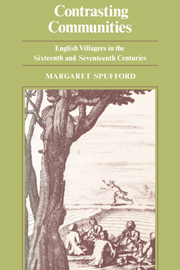Book contents
- Frontmatter
- Contents
- List of maps and graphs
- List of tables
- List of abbreviations
- Acknowledgements
- Dedication
- Introduction
- Map 1 Cambridgeshire: natural boundaries and soil types
- Map 2 Cambridgeshire: county and parish boundaries
- PART 1 People, Families and Land
- PART 2 The Schooling of the Peasantry
- PART 3 Parishioners and their Religion
- 9 Dissent before and after the commonwealth
- 10 A general view of the laity in the diocese of Ely
- 11 Fragmentation and the growth of sects
- 12 The possible determinants of dissent
- 13 The reality of religion for the villager
- Conclusion
- Appendix 1 The Butlers of Orwell
- Appendix 2 Notes on Graphs 3 and 5
- Index of Contemporary Names
- General Index
11 - Fragmentation and the growth of sects
Published online by Cambridge University Press: 25 January 2010
- Frontmatter
- Contents
- List of maps and graphs
- List of tables
- List of abbreviations
- Acknowledgements
- Dedication
- Introduction
- Map 1 Cambridgeshire: natural boundaries and soil types
- Map 2 Cambridgeshire: county and parish boundaries
- PART 1 People, Families and Land
- PART 2 The Schooling of the Peasantry
- PART 3 Parishioners and their Religion
- 9 Dissent before and after the commonwealth
- 10 A general view of the laity in the diocese of Ely
- 11 Fragmentation and the growth of sects
- 12 The possible determinants of dissent
- 13 The reality of religion for the villager
- Conclusion
- Appendix 1 The Butlers of Orwell
- Appendix 2 Notes on Graphs 3 and 5
- Index of Contemporary Names
- General Index
Summary
The failure of the parish church
The ecclesiastical history of the twenty-five years from 1640 onwards was marked by two drastic changes of personnel among the parochial clergy, as first the Laudian and royalist sympathisers lost their livings, to be followed in their turn by those unable to conform to the settlement of 1660. It has been estimated that some thirty per cent of English livings were under sequestration at some time between 1643 and 1660 and that twenty per cent of the restoration clergy were ejected over the country as a whole. The reformation itself had probably obtruded itself far less on the ordinary parishioner than did this ‘further reformation’ so much desired by the Puritans.
Cambridgeshire was as much, or more, affected by the deprivations as the rest of the country. The county contained 121 parishes. Forty-five of these lost their incumbent in the purges of the 1640s and 1650s. Another fourteen incumbents were ejected between 1660 and 1662.
Even though almost exactly half the Cambridgeshire parishes were entirely undisturbed by sequestrations or ejections, and did not even have contentious clergy who were, later in their careers, deprived elsewhere, it is probably impossible to overestimate the magnitude of these changes to the laity. In half the parishes of the diocese, the incumbent continued to officiate as before, but changed his Prayer Book for a Directory.
- Type
- Chapter
- Information
- Contrasting CommunitiesEnglish Villages in the Sixteenth and Seventeenth Centuries, pp. 272 - 297Publisher: Cambridge University PressPrint publication year: 1974



